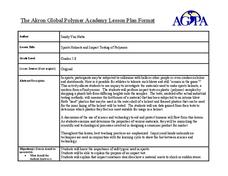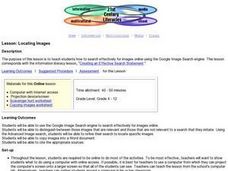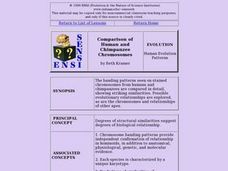Curated OER
Sports Helmets and Impact Testing of Polymers
Students examine the importance of good quality safety gear. In this investigative lesson plan, students will tests various polymers, collect data, and analyze the data to determine which polymer is best for safety helmets. They will...
Curated OER
Creating Coacervates
Students create and observe coacervates. In this origin of life lesson, students create coacervates by mixing carbohydrate and protein solutions. They observe the life-like qualities of the structures and discuss the origin of life.
Curated OER
Exploring Explorations
Students describe human benefits from ocean exploration. In this ocean exploration lesson, students focus on the historical, biological, and physical features of the deep oceans and man's exploration.
Curated OER
Jazz it Up!
Students research the history and contributions of Jazz in their local environments. They then design and create a wide variety of presentations to share with the class using as many mediums as possible.
Curated OER
Follow that Cheese
Students research types of cheeses. In this cheese types lesson plan, students research the origin of cheese and then investigate the area of origin. Students share their reports. Students have a cheese tasting celebration as a...
Curated OER
Study of States in the five U.S. Regions
Fourth graders identify the five regions and the states within them. They research a state from each of five regions, then they choose one of those states to do an extensive research report on following teacher guidelines. They work in...
Curated OER
What did T. rex taste like?
Students examine the three domains of life and explain that all living things share a common ancestor. In this paleontology lesson plan students are introduced to the process of illustrating evolutionary relationships.
Curated OER
Island Biogeography and Evolution
Students develop likely phylogenies for seven related populations of lizards living on the Canary Islands using real data. They organize charts, and record the data for geography, geology, morphology, and molecular genetics.
Curated OER
Locating Images
Pupils discover how to search effectively for images online using the Google Image Search engine. They distinguish between those images that are relevant and those that are not relevant to a search that they initiate and see how to copy...
Curated OER
Where's the Point?
Students examine runoff for the causes, the impact, and the solution. For this investigative lesson students construct a three dimensional model of a watershed and provide information of contaminated runoff to their audience.
Curated OER
WHAT, IF ANYTHING, IS A ZEBRA?
Students read the essay, "What, If Anything, Is a Zebra?" following a teacher made reading guide. They investigate cladistics, shared derived characteristics, with further online research to enhance their study of evolution and...
Curated OER
Pseudogene Suite
High schoolers use Biology Workbench to explore DNA sequence data for the GULOP gene in humans, chimpanzees, orangutans, and crab-eating macaques and the beta globin gene and its pseduogene in humans, gorillas, and chimpanzees.
Curated OER
A Peek at the Past: Gradualism vs. Punctuated Equilibria
Young scholars consider two sets of simulated fossils (caminalcules) that are provided as cutouts. They arrange them on two time scales. One set produces a visual example of gradualism, the other shows punctuated equilibria.
Curated OER
The Magic Hooey Stick
Students examine the use of a "magic hooey stick". They discover the concept of illusions and how science can reveal them. They answer discussion questions to end the lesson.
Curated OER
How's Your Horoscope?
Pupils examine the concept of astrology. They compare their traits with those of standard astrological descriptions. They discuss their findings.
Curated OER
Why Cladistics?
Students explore how biological classification is intimately associated with evolution.
Curated OER
Genetic Jewels: Building the DNA Model
Students construct segments of DNA to create a piece of jewelry. In this genetics lesson plan students create a DNA sequence that they turn into something to wear.
Curated OER
Hominoid Cranium Comparison
Students describe, measure and compare cranial casts from contemporary apes (chimpanzees and gorillas, typically), modern humans and fossil "hominids" (erect and bipedal forms evolutionarily separated from apes).
Curated OER
FOOTSTEPS IN TIME
Pupils measure and correlate their foot lengths and body heights, then use this data to estimate height of Laetoli hominids. They use metric measurement and graphing to determine these heights.
Curated OER
Comparison of Human and Chimpanzee Chromosomes
Students actively engage in the careful analysis of chromosome banding patterns and identify examples of inversion in homologous chromosomes.
Curated OER
Perception is Not Always Reality
Students view various types of illusions. Using one of the illusions, they try to determine how a scientist might explain them. They discover a t-illusion and use their own words to analyze them. In groups, they research a different...
Curated OER
Crime Scene: The Case of the Missing Computer Chip
Middle schoolers, in teams, attempt to solve a simulated crime scene.
Curated OER
Women's Brains
Students experience an example of bias in science dealing with women and gender.
Curated OER
The Natural Selection of Stick-Worms
Young scholars discuss and role-play the elements of natural selection. They use toothpicks to represent Stick-Worms and discover the mechanisms of change of traits in populations.

























